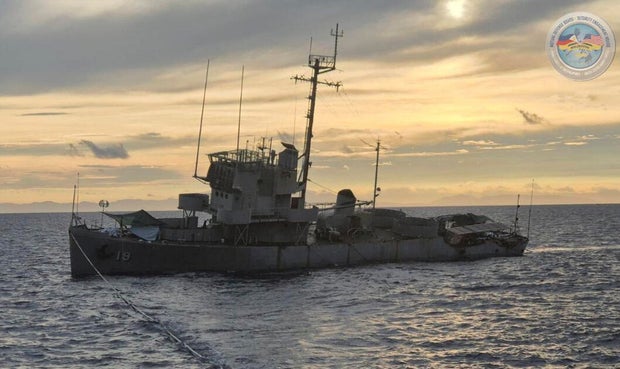A ship from the Filipina Navy of the Era of the Second World War that will be used as an objective in an fighting exercise by the US and the Philippine forces was accidentally sank on Monday before the simulated assault, which caused the drill to be canceled, the US and the Philippine military.
The BRP Miguel Malvar, who was dismantled by the Navy of the Philippines in 2021, in water while towing in rough waters in front of the disputed sea of southern China and sank about 30 nautical miles from the province of Zambales of Western Philippines. No one was on board when the ship was listed then, said the Philippine army.
The US and the Philippine forces would be processed with other zambales living fire maneuvers on Monday despite the premature sinking of Malvar. The ship was built as a patrol boat for the US Navy.
“It is an 80 -year -old ruined ship and could not stand the agitated seas,” said Lieutenant Colonel of Philippine John Paul Salgado to The Associated Press.
Originally called USS Brattleboro, the ship was in service for the US Navy for more than 20 years. It was heavy involved in the Okinawa battle Where the ship “treated more than 200 seriously injured men and rescued more than 1,000 survivors of ships that sank,” according to the United States Navy. Brattleboro won three battle stars Duration of World War II.
/ AP
The ship was sold to the Republic of Vietnam in 1966, said the United States Navy. The Navy of the Philippines acquired and renewed the ship after its Flednam crew after the 1975 Saigon fall, according to the France-Presse agency.
The ship’s inspection exercise was planned in an area on the high seas against the disputed Scarborough Shoal, which has been closely protected by the Chinese coastal guard, the Navy and the susceptible to the ships of the militia.
The Philippines also claims the fishing atol, which is located about 137 miles west of Zambales. Chinese and the Philippines have had increasingly hostile confrontations in Scarborough’s waters and airspace in recent years.
The Boat Inspection Cancel simulation would have been the third to be organized by the allies of the Treaty in recent years. It was supposed to be one of the most prominent aspects of large -scale annual military exercises by the United States and the Philippines from April 21 to May 9 with approximately 14,000 participants from US forces. UU. And the Philippines.
Called Balikatan, Tagalog should be the smell, combat drills have focused more and more on the defense of Filipino sovereignty in the face of the growing aggression of China in the entire Southern China Sea. Beijing claims.
The battle drills of scenes that have bones staged so far, including the retaken of an island of hostile forces, have reflected the guarantees of the Trump administration, even by the Secretary of Defense Pete Hegseth, that is the Philipe for its treesc under an armed attack, even in the southern Sea of China.
On Sunday, the American, Australian and the Philippines forces practiced to resume an island of hostile forces in the coastal city of Balabac in the western province of Palawan, which faces the South China Sea.
Japanese forces and British marines joined as observers of the combat exercise, which “showed the growing interoperability and cohesion between the associated nations in the regional security of the trap,” said Salgado.
“What we have since Trump returned to the White House is a remarkable level of continuity in the Filipinas of the US Alliance, not only in the joint military exercises, but also in US statements that the alliance is” Ironclad in Grossman.
“The Trump administration is trying to maintain pressure on China through its support for the Philippines,” said Grossman, but added that it is not clear “how sustainable this commitment will be given that seems that the Trump administration.
China has vehemently opposed such exercises that involve US forces in or near the southern sea of China or Taiwan, island democracy, which, which Beijing claims As a province and has threatened to force by force if necessary.
However, the United States military officers and the Philippines have insisted that the combat exercises were not designed with China in mind, but serve as a deterrent to acts of aggression in the region.





